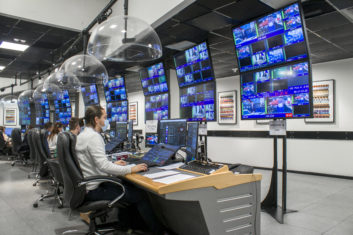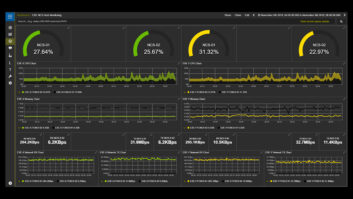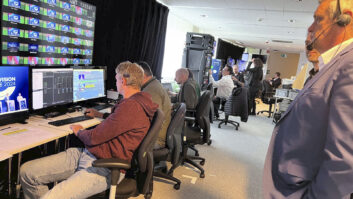Channel One, Russia’s premier television broadcaster, has made the leap from HD-SDI technology to full IP after installing an Evertz Mediator playout and content distribution system at its Ostankino Technical Centre in Moscow.
The system, which incorporates the latest state of the art broadcast technology, is an integrated ecosystem that spans a large number of workflows. It is now being used to broadcast 12 channels of news, sports and entertainment to more than 250 million viewers worldwide.
Over the last four years, the Ostankino Technical Centre has been transferring its own technical infrastructure to IP, using Evertz SDVN technology and equipment. Continuing to adopt this more modern approach to video/audio stream routing and transmission was just one reason why Channel One decided to upgrade its playout facilities. Other factors were equally important and included doubling the number of channels broadcast from six to 12, a desire to transition to ‘channel-in-a-box’ technology for on-air programmes and a need to improve compatibility with the output format requirements of satellite and cable providers. Channel One also wanted to improve its playout system integration with its business applications, and make maximum use of complex graphical capabilities. A final compelling reason was that the HD-SDI equipment it had been using since 2011 was coming to the end of its life and was no longer receiving manufacturer support.
 Undertaking a project of this size and complexity required careful collaboration between Channel One, its system integrator OKNO-TV, its service company Telerent (a division of OKNO-TV that provides round the clock technical support for Channel One’s playout system), and, of course, the Canadian manufacturer Evertz.
Undertaking a project of this size and complexity required careful collaboration between Channel One, its system integrator OKNO-TV, its service company Telerent (a division of OKNO-TV that provides round the clock technical support for Channel One’s playout system), and, of course, the Canadian manufacturer Evertz.
As the leading systems integrator in the Russian Federation, OKNO-TV specialises in the design and modernisation of TV channels and TV studios. Since its formation 30 years ago, OKNO-TV has implemented projects for numerous federal and regional satellite companies, ranging from simple upgrades to complete broadcast centres.
Dmitry Sheykin, Project Engineer for OKNO-TV and technical director of Telerent, says: “We have collaborated with Channel One on many successful projects and we understand the broadcaster’s desire for continuous development and day to day improvements in the quality of its transmissions. New equipment, software and workflows from different vendors and companies are regularly installed and integrated into the Channel One infrastructure. In recent years, Channel One’s engineering team, together with engineers from OKNO-TV, have achieved many ambitious aims including broadcasting in stereo, moving broadcasting from 4:3 to 16:9 and from SD to HD, introducing 5.1 audio, file-exchange between departments, and a sophisticated News and archive system.
“For this latest project, we worked closely to identify Channel One’s exact requirements and choose the most suitable manufacturer, solution and system for their needs. Proof of concept systems were built with five vendors and all of these were shown to Channel One. We also visited several playout centres in Canada, the USA and Europe so that we could speak to real end users and technicians about their experiences. Our final decision to use Evertz was based on that feedback and on previous good experiences with the company, which was known to Channel One. A good example of a previous Channel One/Evertz collaboration was the installation of a special 4K Channel with Dolby Atmos that was built using Evertz equipment for the broadcaster’s coverage of the 2018 FIFA World Cup.”
Igor Yadykin, deputy chief of the technical department at Channel One, says: “As the premier broadcaster in Russia, we have very stringent quality requirements and, given the complexity of this project, it was inevitable that it would take some time to get it right. As well as becoming the first broadcaster in Russia to embrace SMPTE ST2110 (IP), we also wanted to modernise channel distribution and playout with a more software driven, adaptable workflow. Investigating all the different vendors was critical and we found that Evertz was the company that best covered all our wishes. Making major changes to our playout facility is not something that we do often so we wanted to be sure it was a good investment. We knew that the playout system would have an expected service life of seven to eight year and would be operating non-stop on a 24/7 basis, so it had to be robust and reliable.”
The Evertz Mediator system installed at Ostankino includes 29 Overture (ORT) Live integrated playout engines; 14 ORT Media Client record servers; 2 Render-X proxy generator servers; an advanced multi-node virtualisation environment hosting Mediator core and computer nodes; 15 VUE CUBE workstations and two Isilon storage clusters (main and backup), each with 9 nodes.
 For the IP infrastructure, OKNO-TV installed two Evertz EXE routers (main and back-up) with MAGNUM SDVN and Client Host servers. An EQX router with MAGNUM were also installed for ingest. Other components include monitoring tools such as VistaLINK Pro with graphics for the network management system (NMS) and inSITE for real-time data analytics; four TR4800E tally routers; two 5700MSC-IP Grand Master Clock and Video Master Clock systems; a 5601AC02 Automatic Changeover and a host of frames with modular products incorporating converters, amplifiers and infrastructure equipment.
For the IP infrastructure, OKNO-TV installed two Evertz EXE routers (main and back-up) with MAGNUM SDVN and Client Host servers. An EQX router with MAGNUM were also installed for ingest. Other components include monitoring tools such as VistaLINK Pro with graphics for the network management system (NMS) and inSITE for real-time data analytics; four TR4800E tally routers; two 5700MSC-IP Grand Master Clock and Video Master Clock systems; a 5601AC02 Automatic Changeover and a host of frames with modular products incorporating converters, amplifiers and infrastructure equipment.
“Channel One is the umbrella name for a number of different channels,” says Igor Yadykin. “The new playout system was created for our Channel One time zone channels, of which there are 12 – each generating SD and HD signals at the same time. These channels are hourly versions of Channel One, running from nine hours ahead to one hour behind Moscow time. The programme content requirements for each time zone do differ so we edit as we go along to ensure that what we are broadcasting is most suited to the region it is covering. This is a complicated process and with 99.8 per cent of the Russian population watching Channel One, it is imperative that it runs smoothly.
“Previously, some of the time zones were doubling up but when we changed the system, we added five more hourly zones so that each zone had its own playout,” Yadykin adds. “We now have full redundancy, with separate racks and equipment for each channel, plus two spares.”
Moving to new technology inevitably requires re-training for operators. In Russia, staffing levels are high and Channel One needed to re-train over 200 people whose roles covered ingest and archive as well as playout.
“The new system is very different from the D Series interfaces our staff had been using for about 20 years, so it took a while for people to change their approach and embrace new ideas and practises,” Yadykin says. “Also, we had some hold ups because of Covid and not being able to have a lot of people in the same room at the same time, but we got there eventually.”
With respect to training, it was clear that understanding Channel One’s workflow, was going to be crucial to the success of any training programme. Channel One created a team of super users from its programme department and, together with staff from OKNO-TV, they began to study the capabilities of the system. Once they were familiar with it, they were able to train other staff.
“Throughout this project, options for reconfiguring and adapting Mediator were discussed,” says Max Popov, Evertz sales director for Northern Europe and Russia. “This was undoubtedly a challenging project as the quality requirements from Channel One were so high and because Evertz accommodated many new wishes and requests from a large number of different Channel One departments. The feedback they gave us certainly elevated the capabilities and quality of our system.”
Dmitry Sheykin adds that, from an end user point of view, getting to grips with the new system was initially challenging but once staff understood its capabilities, they were delighted by what it could achieve.
“The main highlight is having all control of the processes of air correction and modification carried out through a modern HTML5 web client,” Sheykin says. “In the automation system’s client application, users can now schedule and view a copy of the broadcast programmes in low resolution with accuracy up to the frame.”
“Playing files, switching to external lines, keying multilayer internal and external graphics, inserting SCTE marks for inserting advertising and subtitles, loudness control, generation of multichannel sound and simultaneous formation of air programming in SD and HD formats – all of this is now implemented with software code,” Sheykin says. “We have also provided Air master control mixers (VUE) for operational manual generation of programmes, with control carried out through graphic panels with touch screen monitors. In addition, the system provides manual control of graphic design output from third party devices such as VizRT. This means that, for the first time ever, Channel One users can dynamically link external graphics devices from a common pool to an air channel and transmit text data to graphic scenes directly from the schedule.”
“The Channel One project was a steep learning curve for everyone and we are delighted that this close collaboration has allowed us to meet our customer’s requirements,” says Robert Peter, Evertz VP of international operations. “It is satisfying to know that our Mediator system has been so well received by a broadcaster that is internationally renowned for its very high technical standards.”







